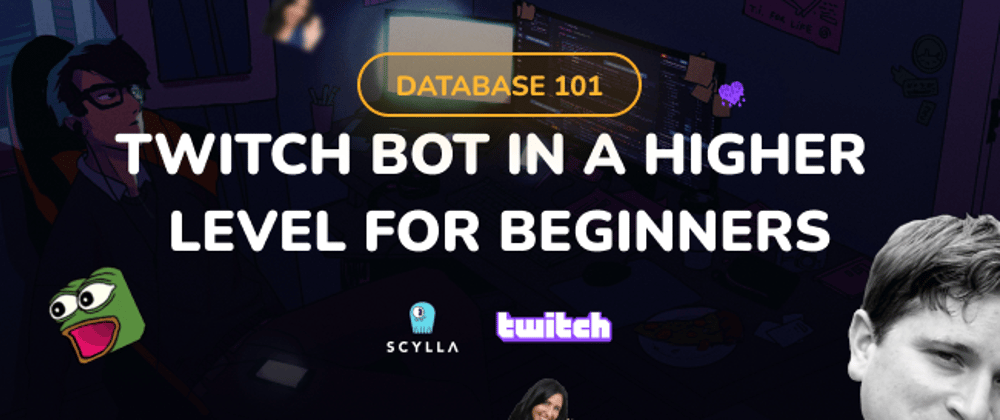
I kinda like the idea of writing about social media + databases and it seems the readers here are too. So, let’s explore it in a new direction: loo...
For further actions, you may consider blocking this person and/or reporting abuse


Your article provides valuable insights and hands-on knowledge for developers looking to work with databases and social media platforms. Excellent work in presenting complex concepts in a clear and captivating way!
Excellent article, and this collected data is great when considering its possible application in business intelligence and gathering insights for potential sponsors, in addition to temperature mapping on when certain subjects are addressed. Incredible article as always.
Really good post! :)
I hope one day I can write something close to this level.
Nice article btw
it was nice to follow the process of creating this article on Twitch live! Do it more times 😊
Yay! Many thanks for your articles. I'm a beginner and having great content like this to guide me is always nice. Keep up your amazing work.
Nice cousin!!
very nice content, as always!
Awesome!
Nice article cousin!
As a frontend engineer who is also interested in Backend, I've learnt a lot from your post. Thank you so much. If I had known more about the part, I could've learnt more.
Just connected with you on LinkedIn!
Let's keep chatting! Nice to meet you btw!
Great article, thank you for share the knowledge you learned, always helping me to understand database better. Great job Daniel!
Great article!
Great article!
Poggers article!
Excellent article, thank you for sharing your knowledge! Keep up your amazing work Daniel!
Thank you for this amazing content, bro! ❤️
Creating a Twitch bot can be a fun and rewarding project, especially for beginners interested in coding and learning about chatbots. Here's a beginner-friendly guide to creating a simple Twitch bot at a higher level:
Step 1: Choose Your Programming Language
Choose a programming language that you're comfortable with and supports Twitch bot development. Popular options include Python, JavaScript (Node.js), or even languages like Java or C#.
Step 2: Set Up a Twitch Account
If you don't have one already, create a Twitch account that will act as your bot. This account will be used to authenticate your bot with the Twitch API.
Step 3: Register Your Bot with Twitch
Go to the Twitch Developer portal and register your bot as an application. This will generate a client ID and secret, which you'll need for authentication.
Step 4: Install Necessary Libraries or SDKs
Depending on your chosen programming language, install any libraries or SDKs that provide access to the Twitch API. For example, if you're using Python, you might use the twitchio library.
Step 5: Write Your Bot Code
Write the code for your Twitch bot. At a high level, your bot should connect to Twitch chat, listen for messages, and respond accordingly. You can implement features like greeting new viewers, responding to specific commands, or moderating the chat.
Step 6: Implement Authentication
Use the client ID and secret generated earlier to authenticate your bot with the Twitch API. This typically involves sending an authentication request and obtaining an access token.
Step 7: Connect to Twitch Chat
Connect your bot to Twitch chat using the appropriate library or SDK. Join the channels where you want your bot to operate, and start listening for messages.
Step 8: Implement Bot Commands and Responses
Write code to parse incoming messages and respond to specific commands or triggers. For example, if a viewer types "!hello" in chat, your bot could respond with a greeting message.
Step 9: Test Your Bot
Test your bot in a Twitch chat channel to ensure that it's functioning as expected. Debug any issues and make any necessary adjustments to your code.
Step 10: Deploy Your Bot
Once you're satisfied with your bot's functionality, deploy it to a server or cloud platform so that it can run continuously. Make sure to handle errors gracefully and monitor your bot for any issues.
Step 11: Maintain and Update Your Bot
Regularly maintain and update your bot to fix bugs, add new features, or adapt to changes in the Twitch API or community guidelines.
By following these steps, you can create a simple Twitch bot at a higher level, even as a beginner. As you become more comfortable with coding and bot development, you can explore more advanced features and functionalities to enhance your bot's capabilities. Happy coding!
Great article! I'm a frontend dev and I've never made a project that consumes that much data and now I'm realizing that I'm missing out 😂 Thank you for the insights
Nice content! Thank you.
Nice Content!
Muito bom